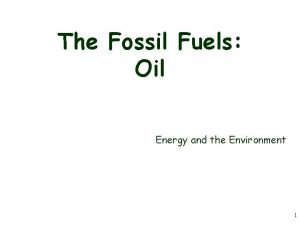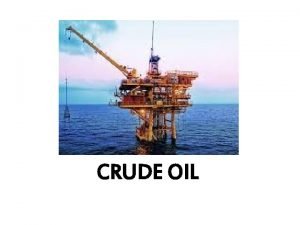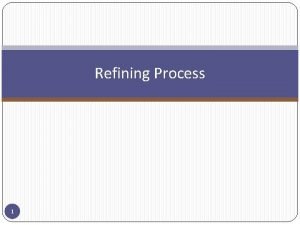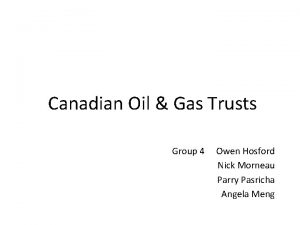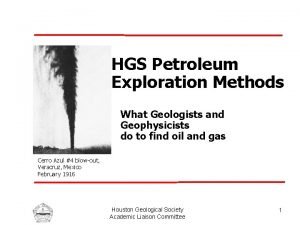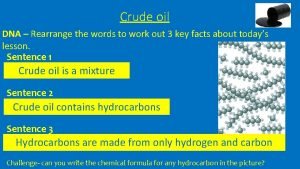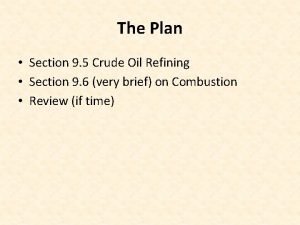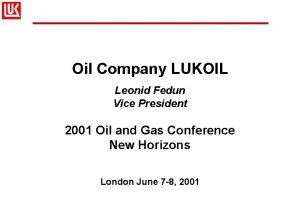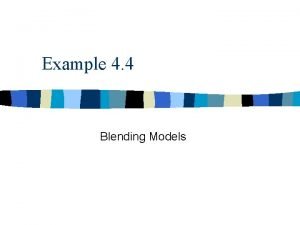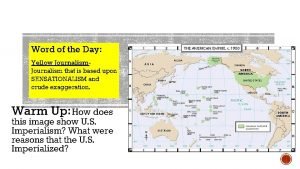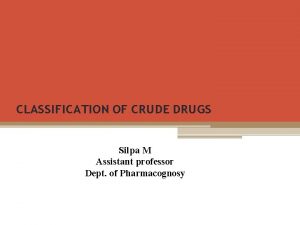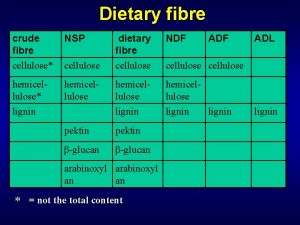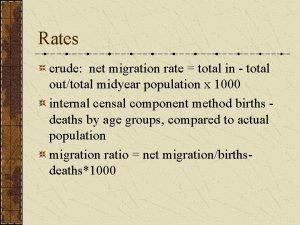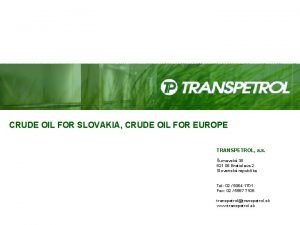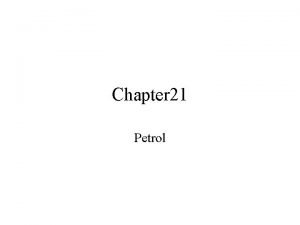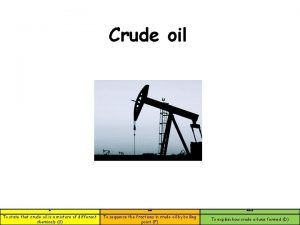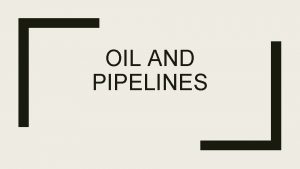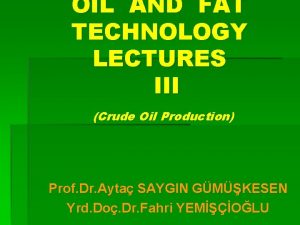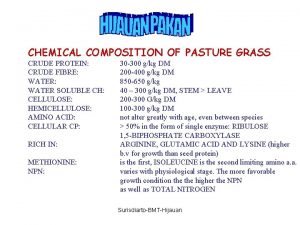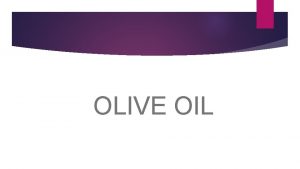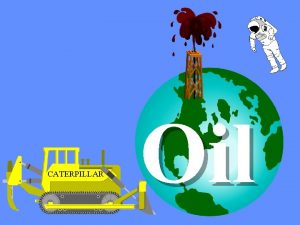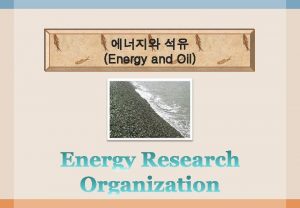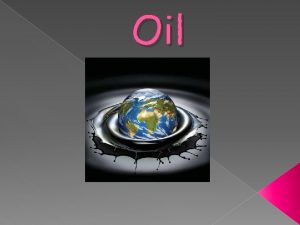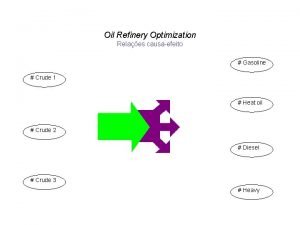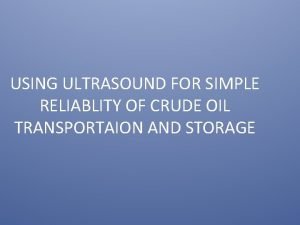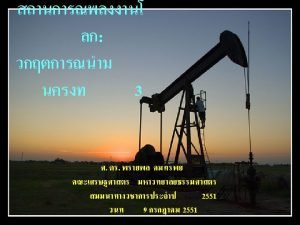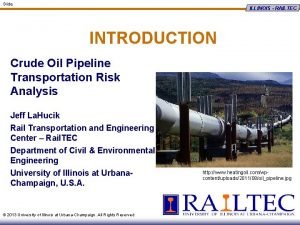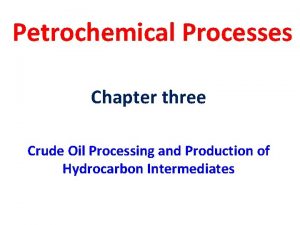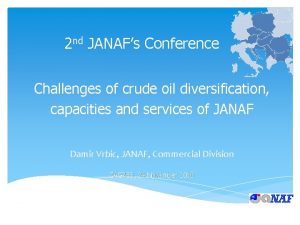CRUDE OIL What is crude oil Crude oil
























- Slides: 24

CRUDE OIL

What is crude oil? Crude oil is a fossil fuel that comes directly from the Earth’s crust and is one of the most important substances in the world. Crude oil is a complex mixture of hundreds of compounds.


How crude oil was formed • Microscopic plants and animals die and fall to the sea bed • Layers of sand mud form on top • Pressure and high temperature cause oil to form • Oil obtained by drilling

How did it get there? Put these sentences into the right order: A. Millions of tiny animals lived in the seas B. The pressure and heat of the rocks turned the dead animals into oil C. As the dead animals decayed they were covered with thick layers of mud and sand (sediment) D. When the animals died their bodies fell to the bottom of the sea E. The layers of mud slowly changed into layers of rock

Crude oil (Petroleum) • A mixture of hydrocarbons (compounds which contain only hydrogen and carbon atoms)

Hydrocarbons Many of the compounds in crude oil only contain the elements carbon and hydrogen. They are called hydrocarbons. Most hydrocarbons in crude oil are compounds called alkanes. Alkanes are made up of a single chain of carbon atoms with hydrogen atoms bonded to them. Methane, propane and butane are all alkanes.

HYDROCARBONS OR NOT? HYDROCARBON CH 3 – CH 2 –CH 3 CH 2 = CH 2 NO HYDROCARBON CHO – CH = COH –CH 2 OH CH 3 – CO – CH 3 – NH 2 CHOCH –CH CH CH –=2 CH =NH COH C – 2 2 CH =–CH CH –CH 3– 3–CO 3 32 2 OH

Alkanes are a family of hydrocarbon compounds with the general formula Cn. H 2 n+2. This means that an alkane will have two hydrogen atoms for every carbon atom, plus two more. The simplest alkane is methane. It has the formula CH 4. The second simplest alkane is ethane. It has the formula C 2 H 6. The third simplest alkane is propane. It has the formula C 3 H 8.

Saturated hydrocarbons Hydrocarbons like alkanes, which contain chains of carbon atoms joined by single carbon–carbon covalent bonds, are called saturated hydrocarbons. Some hydrocarbons contain carbon–carbon double or even triple bonds. These are called unsaturated hydrocarbons. A saturated hydrocarbon. An unsaturated hydrocarbon.

SATURATED OR UNSATURATED? SATURATED UNSATURATED CH 3 – CH 2 – CH 3 – CH = CH – CH 3 CH 2 = CH 2 CH 3 – CH 2 – CH 3 –=CH CH – CH CH 3 CH C 3 –=CH CHCH 2 CH 3 – CH 23 – 2– 32 CH 3 3

What is fractional distillation? Fractional distillation is a process used to separate a mixture of liquids that have different boiling points. Fractional distillation is used to separate crude oil into useful products called fractions. It can be done industrially and in the laboratory.

Can crude oil be made useful? Crude oil is a hydrocarbon (it contains only hydrogen and carbon atoms). Crude oil itself has no uses – it must first be processed or refined. This is done in an oil refinery. During refining, compounds in the oil are separated into simpler groups called fractions. Each fraction contains a mix of compounds with a similar number of carbon atoms.

Fractional distillation of crude oil How is crude oil separated into fractions? 1. Oil is heated to about 370 °C and pumped into the bottom of a tall tower called a fractionating column, where it vaporizes. 2. The column is very hot at the bottom but much cooler at the top. As the vaporized oil rises, it cools and condenses. 3. Heavy fractions (containing large molecules) have high boiling points and condense near the bottom of the column. 4. Lighter fractions (containing small molecules) have lower boiling points and condense further up the column.

Different fractions from oil

How do fractions differ? Hydrocarbons in different fractions differ from each other in a number of ways. These differences include: the number of carbon and hydrogen atoms they contain boiling point ease of ignition (how easy it is to set it alight) viscosity (thickness).

Hydrocarbons as fuels Over 85% of crude oil is used as a fuel for heating and transport. Only 8% is used to make plastics and other chemicals. A large amount of oil is used as fuel because the hydrocarbons in the fractions burn easily and produce a large amount of useful energy. A fuel is a substance that reacts with oxygen to produce useful energy.


What is LPG used for? Liquid petroleum gas (LPG) contains propane and butane. They are stored under pressure in metal cylinders. LPG is used for heating and cooking, especially where piped gas cannot be used, such as camp sites and boats.

What is gasoline used for? Gasoline is one of the most important fractions because it is used as a fuel for cars. The gasoline fraction must be refined before it can be used in cars as petrol. Impurities are removed, and chemicals are added to ensure the engine runs smoothly. In the past, these chemicals were lead compounds but because of lead’s harmful effect on health and the environment, they have been replaced by safer compounds.

What is naphtha used for? Naphtha is a very important fraction that has many uses. For example, it is: a raw material (feedstock) in the production of chemicals and plastics used as a cleaning fluid and industrial solvent (a substance that can dissolve another substance) added to petrol and other fuels.

What are kerosene & diesel used for? Kerosene is mainly used as aviation fuel for jet aircraft. It is also used in central heating systems, lamps and stoves. Diesel is mainly used as a fuel for lorries, buses and cars, and in some boats.

What are lubricating & fuel oil used for? Lubricating oil, as its name suggests, is used as a lubricant in products with moving parts, such as engines. Fuel oil is a heavy fraction used as a fuel for large industrial boilers, oil-fired power stations and ships.

What is the residue used for? Residue contains paraffin waxes and bitumen, the heaviest product to come from an oil refinery. Paraffin waxes are used in candles and waterproofing. Bitumen is used in road construction and waterproof material.
 Crude oil
Crude oil How is crude oil formed
How is crude oil formed Catalytic cracking diagram
Catalytic cracking diagram Oil sands extraction process diagram
Oil sands extraction process diagram What products are made from oil
What products are made from oil Crude oil contains
Crude oil contains Crude oil refining process
Crude oil refining process Preparation of emulsion
Preparation of emulsion Thesis for industrial revolution
Thesis for industrial revolution Crude income
Crude income What is physiological density ap human geography
What is physiological density ap human geography Background information example
Background information example Spanish brute political cartoon
Spanish brute political cartoon Classification of crude drugs
Classification of crude drugs Tactile localization meaning
Tactile localization meaning Journalism based on sensationalism and crude exaggeration
Journalism based on sensationalism and crude exaggeration Dried juice in pharmacognosy
Dried juice in pharmacognosy Bidextrous grasp
Bidextrous grasp Crude fiber examples
Crude fiber examples Lycopodium spore method for percentage purity
Lycopodium spore method for percentage purity Crude net migration rate
Crude net migration rate Ecumene definition ap human geography
Ecumene definition ap human geography Sensations def
Sensations def Crude population density vs physiological density
Crude population density vs physiological density Crude analysis uml
Crude analysis uml
